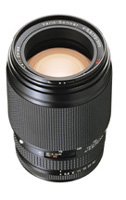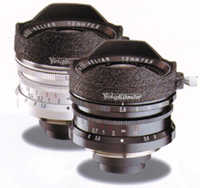Year End Wrap Up 2001
New Lenses For 35mm SLR And Rangefinder Cameras
|
Minolta's New "D" Series Compact and lightweight (2.8x 2.7", 62mm filter size, 14 oz), the new AF 24-105mm f/3.5-4.5(D) zoom incorporates two aspherical elements to counter aberrations for excellent performance. A small/lightweight zoom, the new AF 100-300mm f/4.5-5.6(D) APO tele-zoom includes two low dispersion elements to help correct chromatic aberration. At a much lower ($200) street price, there's the new 75-300mm f/4.5-5.6 (D) with conventional optics, suitable for first time SLR buyers. The new AF Macro 100mm f/2.8 (D) is well corrected for curvature of field, curvilinear distortion, and various aberrations. An extremely "fast" portrait lens, the pro-model AF 85mm f/1.4 G(D) inherits the high quality optics of the previous G model; maximum sharpness at all apertures and focused distances is assured by a floating element focusing design. |
|
Expanding Contax AF Line
The Vario Sonnar T* N-24-85mm f/3.5-4.5 USM zoom features two aspherical elements plus two of anomalous dispersion glass for exceptional performance at all focal lengths. The telephoto zoom Vario-Sonnar T* 70-300mm f/4 USM includes an element of anomalous dispersion glass to control chromatic aberration plus close focusing to 3.28 ft. Other AF T* lenses that were announced include a Planar 85mm f/1.4 and a Vario-Sonnar 17-35mm f/2.8 zoom. |
|
New Sigma Ultra Wides |
|
High Tech Canon Lenses In response to overwhelming demand, Canon has added Image Stabilization to another pro zoom. The new EF 70-200mm f/2.8L IS USM includes the renowned optical and super (including four Ultra-Low Dispersion glass elements) of the original f/2.8L USM model and offers even better autofocus performance. As a bonus, it focuses closer (4.6 ft) and is more moisture and dust-resistant. Of course, the stabilizer makes it more useful in low light with slow film. An improved vibration sensor maintains compact lens size, provides smoother IS operation plus a full three stop advantage for sharp pictures at much longer shutter speeds. The stabilizer also works well when the lens is mounted on a tripod, overcoming vibrations from reflex mirror bounce and wind. Since digital camera owners want short lenses for true wide angle effects, Canon also introduced the weather-resistant EF 16-35mm f/2.8L USM with close focusing to 11" plus a drop-in gel filter holder. The first EF-series lens to incorporate three types of aspherical elements, for even higher image quality than the EF 17-35mm model, this one also includes two UD elements to correct chromatic aberration for high contrast and resolution. An ideal companion for the new EOS-1D (digital SLR), this zoom is equally useful with conventional EOS cameras. |
|
Wide Angle To Telephoto
Zooms One manufacturer released a professional zoom in this category. The Sigma AF 24-70mm f/2.8 EX DG (Aspherical) is truly impressive, because it incorporates three aspherical plus two Super Low Dispersion elements (reviewed October, 2001 issue). This rugged, large, and hefty zoom delivers a very high level of performance and promises long-term durability. If you need a very affordable lightweight model, check out the new Sigma AF 24-70mm f/3.5-5.6 Aspherical with one aspherical element, probably adequate for a lens without very wide apertures. |
|
When testing Tamron's SP AF 24-135mm f/3.5-5.6 AD zoom (reviewed June, 2001 issue), I found it highly versatile for travel photography, and capable of producing excellent image quality. It's very rugged, reasonably compact, and lightweight (18.5 oz) and features four hybrid aspherical elements plus an unusual anomalous dispersion element; the combination corrects all types of optical aberrations and distortion. Although it starts at 28mm, the new Tamron AF 28-200mm f/3.8-5.6 Aspherical XR [IF] Macro--the smallest and lightest in its class--will be a best seller, just like its Super II predecessor. For information as to its other advantages--and the high tech optical and mechanical components employed--see my review in this issue. |
|
Tokina's long-awaited AT-X 24-200mm f/3.5-5.6 zoom reached stores this year. This lens has two aspherical plus two Super Low Dispersion elements. The first zoom including this range of focal lengths, it's reasonably small (3.5x 3.2") and not too heavy (24 oz). Es-pecially for family vacation trips, hiking, cycling, and other activities, it may be the only lens you'll ever need to carry. Special Lenses |
|
Also manual focus, the new Voigtlnder 12mm f/5.6-R Heliar Aspherical is the shortest rectilinear (non-fisheye) lens on the market, with an amazingly wide 121 angle of view. Designed for the Bessa L camera, it will fit any rangefinder model that has the L screwmount with TTL light metering. This is a compact (1.5x2") and lightweight lens (3.2 oz plus 12mm viewfinder, included) and it will accept 72mm filters with an optional adapter. Now distributed by Schneider Optics, all Voigtlnder lenses are beautifully made and finished, and available in silver and black. This one also incorporates a high quality optical formula with an aspherical element. Pentax also released a special model, the FA 31mm f/1.8AL Limited with gorgeous satin aluminum finish and ultra-wide aperture, great for low-light photography. This AF model is also compatible with manual focus K-mount cameras, and is reminiscent of lenses made three decades ago. It incorporates a glass molded aspherical lens and floating element mechanism to correct aberrations at all focused distances down to a mere 12". Yes, it's expensive as you'd guess from the metal construction and superb optical formula confirmed in my tests but it offers high prestige value, excellent build quality, and an elegant retro look. |
|
Lighter Weight/Closer
Focusing Far more affordable, Nikon's new AF-S 300mm f/4 ED IF has similar features: Silent Wave focus motor, instant switching from AF to manual focus at any time, plus compatibility with the tele-converter TC-14E that maintains autofocus. A built-in lens hood, two large ED glass elements, removable tripod collar, and dust/water-resistance make this a highly desirable lens. Note: For full specifications on these and other new lenses, check out Shutterbug's Photography Buyer's Guide 2001 or visit the distributors' web sites. Manufacturers/Distributors |
- Log in or register to post comments










































